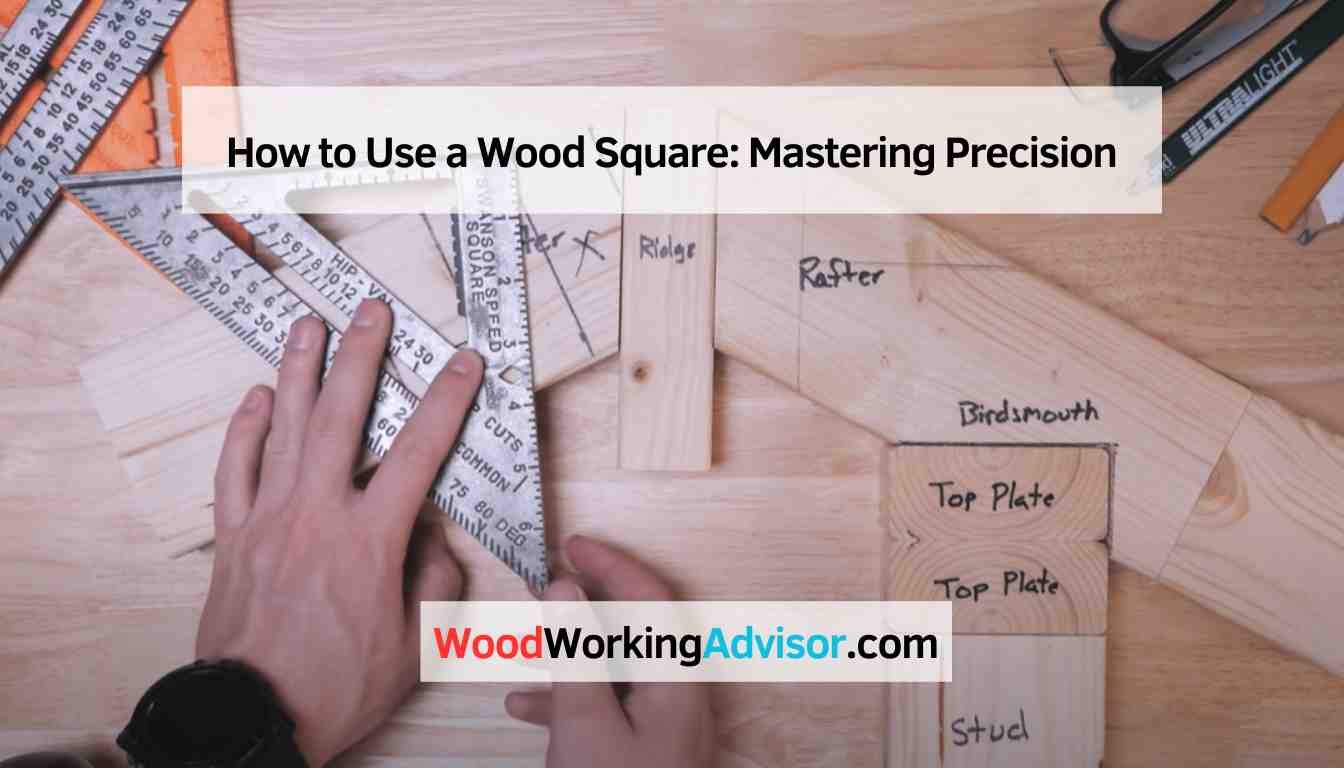To use a wood square, align the square’s edge with the wood’s edge or corner and mark the desired measurement. Alternatively, use the square to create perpendicular lines by aligning the square against the wood’s edge and marking the line.
A wood square is a useful tool for precise woodworking measurements and creating straight lines on wood surfaces. Welcome to the world of woodworking! If you’re new to this craft or just starting out, learning how to use basic tools like the wood square is essential.
A wood square, also known as a try square or carpenter’s square, is a simple yet versatile tool that can aid you in achieving accurate measurements and creating straight lines on wood. Whether you’re building furniture, framing a structure, or working on various woodworking projects, using a wood square correctly can make all the difference in the final outcome. We will explore the proper techniques and practical applications of using a wood square to enhance your woodworking skills.

Credit: tikweld.com
Getting Familiar With Wood Square
If you are a woodworking enthusiast or someone who loves to engage in DIY projects, understanding how to use a wood square is essential. A wood square, also known as a speed square or rafter square, is a versatile tool that can be used for a wide range of tasks. It is designed to help you achieve accurate measurements and angles while working with wood. In this blog post, we will guide you through the fundamentals of using a wood square, starting with getting familiar with its various parts and types.
Parts Of A Wood Square
A wood square consists of several key components, each serving a specific purpose in woodworking. By understanding the various parts, you can effectively utilize the tool to its fullest potential.
| Body | The body of a wood square is typically made of durable and lightweight material such as aluminum or steel. It serves as the main structure of the tool, providing stability and support during measurements. |
| Base | The base is the flat surface of the wood square that rests against the workpiece. It ensures stability and accuracy when measuring and marking angles. |
| Tongue | The tongue is a protruding portion of the wood square that extends beyond the base. It allows for precise measurements and acts as a guide when marking cut lines or angles. |
| Graduations | The graduations on a wood square are numerical markings along the edges of the tool. They provide reference points for measurements and help determine the desired angles or lengths accurately. |
Types Of Wood Squares
Wood squares come in different types, each catering to specific woodworking tasks. Knowing the various types will enable you to choose the right one for your particular project:
- Try Square: This wood square features a shorter tongue, making it ideal for marking 90-degree angles and checking for squareness.
- Speed Square: The speed square is a versatile tool that combines the functions of a try square, miter square, and protractor. It has additional markings and angles for quick measurements and layout work.
- Combination Square: The combination square is an all-in-one tool that includes a try square, miter square, and depth gauge. It is perfect for precise measurements, marking angles, and locating depths.
- Rafter Square: Also known as a framing square, the rafter square aids in cutting and marking roof rafters and stair gauges. It features measurements and angle markings specific to roofing and stair construction.
By understanding the various parts and types of wood squares, you can confidently use this versatile tool for woodworking projects. In the next sections, we will delve into the step-by-step process of using a wood square for different tasks. Stay tuned!

Credit: www.amazon.com
Preparing Your Wood Square
Before using a wood square for your next woodworking project, it’s important to adequately prepare it to ensure accuracy and longevity. In this section, we will guide you through the necessary steps to get your wood square ready for use.
Checking For Accuracy
Before diving into your woodworking project, it’s crucial to verify the accuracy of your wood square. Here are some steps to follow:
- Check the Straightness: Lay the wood square against a straight edge or a known flat surface. Ensure that the square’s blade aligns perfectly along the edge without any gaps or overlaps.
- Inspect the 90-Degree Angle: Position the square in a corner of a flat surface and verify that the blade forms a perfect 90-degree angle. Measure the width of the gap between the blade and the surface to double-check its accuracy.
- Test for Squareness: Place the wood square against the edges of different woodworking components, such as boards or panels, and confirm that they align properly. This will help ensure precise and square cuts throughout your project.
Note: If you find any inaccuracies, it may be necessary to adjust or replace your wood square to maintain precise measurements and angles.
Cleaning And Maintenance
Proper care and maintenance of your wood square will help extend its lifespan and accuracy. Here are some guidelines to keep in mind:
- Remove Accumulated Debris: Regularly clean your wood square to eliminate any dust, shavings, or other foreign particles. Gently wipe the square’s surfaces using a soft cloth or brush.
- Avoid Moisture Exposure: Wood squares are sensitive to moisture, which can cause warping or damage. Store your square in a dry location, and avoid exposing it to excessive humidity or wet conditions.
- Apply Lubrication: To prevent rust and ensure smooth movement, lightly oil the hinge mechanism of your wood square. Be sure to wipe off any excess oil to avoid leaving stains on your materials.
Note: By regularly cleaning and maintaining your wood square, you’ll not only preserve its accuracy but also enhance its overall performance and longevity.
Mastering Wood Square Techniques
Basic Measurements
Making precise measurements using a wood square is essential for accurate cuts and constructions.
- Ensure the wooden square is placed flush against the workpiece.
- Use a pencil to mark the measurement line for cutting or marking.
- Double-check your measurement before making any cuts.
Advanced Usages
Maximize the functionality of a wood square by exploring advanced techniques.
- Try using the square as a guide for circular saw cuts.
- Utilize the square for checking the squareness of joints and corners.
- Experiment with different angles and measurements for diverse woodworking projects.
Achieving Precision
Achieving precision when using a wood square is essential to ensure accuracy in your woodworking projects. Whether you are measuring, marking, or checking for squareness, following the right techniques can make a significant difference in the quality of your work. This section will provide you with valuable tips for accurate results as well as common mistakes to avoid when using a wood square.
Tips For Accurate Results
To achieve precise measurements and markings with a wood square, consider the following tips:
- Use a pencil with a fine tip to make accurate markings on the wood.
- Ensure that the wood square is securely held against the workpiece to prevent any movement during measurement.
- Always double-check your measurements to minimize errors.
- Keep the wood square clean and free from any debris that could affect its accuracy.
Common Mistakes To Avoid
When using a wood square, it’s important to be aware of common mistakes that can lead to inaccurate results. Avoid the following pitfalls:
- Using a dull pencil that results in imprecise markings.
- Not firmly holding the wood square in place, leading to inaccuracies in the measurements.
- Assuming the wood square is perfectly square without checking its accuracy beforehand.
- Ignoring the cleanliness of the wood square, which can lead to inaccurate measurements.
Incorporating Wood Square In Projects
The wood square is a versatile and essential tool in carpentry and woodworking projects. Understanding how to effectively incorporate a wood square in various projects not only ensures precision and accuracy but also simplifies complex tasks. Below, we’ll explore its applications in carpentry and woodworking projects.
Carpentry Applications
In carpentry applications, a wood square is used to ensure that joints and corners are perfectly aligned. Whether you are working on constructing a wooden frame, installing fixtures, or creating shelves, the wood square serves as a reliable guide to achieve precision and accuracy.
Woodworking Projects
When it comes to woodworking projects, the wood square is a fundamental tool in measuring wood, marking cut lines, and verifying the accuracy of angles. Whether you are assembling furniture, crafting intricate designs, or building cabinets, the wood square is indispensable to achieve flawless and symmetrical woodworking creations.
Learning From Expert Woodworkers
Guidance From Professionals
Professional woodworkers offer valuable insights and tips when it comes to using a wood square.
- Watch demonstrations: Observe skilled woodworkers use the wood square in various projects.
- Ask questions: Engage with experts to clarify doubts and seek guidance for precision.
- Learn techniques: Discover advanced methods and tricks that only experienced woodworkers know.
Online Resources And Courses
Explore online platforms that provide comprehensive guidance on utilizing a wood square effectively.
- Video Tutorials: Access step-by-step tutorials from expert woodworkers to improve your skills.
- Interactive Courses: Enroll in online courses to deepen your understanding of woodwork principles.
- Forums and Communities: Engage with like-minded individuals to share experiences and gain valuable insights.
Frequently Asked Questions For How To Use A Wood Square
What’s The Best Way To Use A Wood Square?
Using a wood square involves placing it against the wood surface to ensure perfect right angles and straight edges. It’s essential for precise measurements and cutting. To use it effectively, align the square carefully and use a pencil to mark the wood for accurate cuts.
What Are The Common Mistakes When Using A Wood Square?
One common mistake when using a wood square is not properly aligning it with the wood surface, leading to inaccurate measurements. Another mistake is applying too much pressure while marking, which can cause the square to shift. Additionally, not maintaining the square’s edges can result in imprecise markings.
Why Is A Wood Square Essential For Woodworking Projects?
A wood square is essential for woodworking projects due to its ability to ensure accurate measurements and precise right angles. It helps in maintaining the integrity of the design and guarantees that the wood pieces fit together seamlessly. Using a wood square contributes to professional-looking and structurally sound woodworking projects.
Conclusion
Mastering the wood square opens up endless possibilities for precision in your woodworking projects. With practice and patience, you can elevate your craftsmanship and create stunning pieces. Embrace the versatility of this tool and let your creativity flow. Start experimenting and see your woodworking skills soar.

